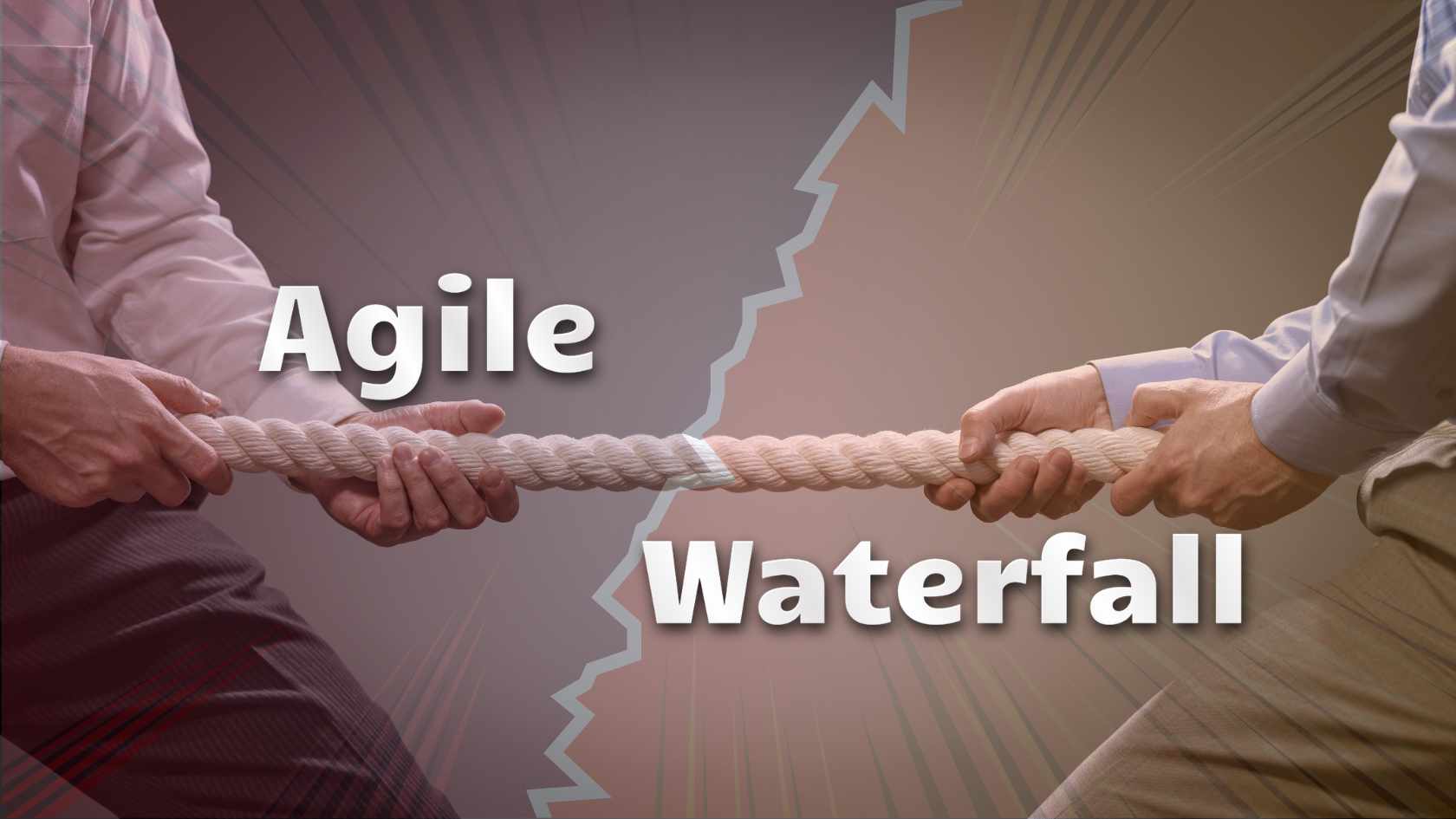When it comes to project management, Agile and Waterfall are the two heavyweights, each bringing a unique approach to the table. Think of Waterfall as the meticulous planner, everything is mapped out step-by-step before the journey begins. It thrives on predictability, where every phase must be completed before moving to the next. On the other hand, Agile is an adventurous innovator, embracing change and flexibility. It breaks projects into bite-sized chunks, delivering value incrementally and continuously refining based on feedback.
Table of Contents
The choice between Agile vs Waterfall isn’t just about methodology, it’s about mindset. Do you need a structured roadmap or an adaptable framework? Each approach shines in its own way, depending on the project’s demands, goals, and challenges. In this guide, we’ll explore the key differences, helping you decide which methodology is the perfect fit for your project journey.
Agile Methodology
Agile methodology is more than simply a project management tool; it is a philosophy that stresses flexibility, collaboration, and value delivery at all stages. Unlike traditional systems that rely on fixed plans, Agile thrives in dynamic circumstances where change is unavoidable. Consider this: a team working in short bursts, continually developing and adjusting to input while putting the customer’s demands at the forefront. Agile enables teams to face issues head on, helping projects stay on track while maintaining quality. Whether developing cutting-edge software or refining new solutions, Agile’s versatility makes it the best instrument for success in today’s fast-paced world. In fact, 86% of marketers plan to shift some or all of their marketing teams to Agile methodologies, highlighting the increasing adoption of Agile for its ability to drive faster, more responsive marketing strategies and improved project outcomes.
Also read: Understanding the New Product Development Process
Benefits of Agile
1. Flexibility to Adapt to Changes
Agile thrives in ever-changing environments. It helps teams adjust to new requirements or market shifts, even late in a project. Instead of resisting change, Agile views it as a way to improve results. Teams can quickly apply feedback and shift strategies without losing momentum. This adaptability keeps projects relevant and valuable to stakeholders. Agile builds confidence in handling uncertainty, making it ideal for industries like tech and product development.
2. Enhanced Collaboration
Agile is all about teamwork. It encourages open communication between developers, stakeholders, and customers. Everyone stays on the same page with clear goals and expectations. Regular meetings, like daily stand-ups, keep everyone informed and involved. This leads to faster problem-solving and a sense of shared ownership. By breaking down silos, Agile makes processes smoother and outcomes better. The collaborative approach also creates a positive environment where innovation and teamwork flourish.
3. Customer-Centric Approach
Agile puts customers first. Continuous feedback ensures their needs are met throughout the project. Customers can review progress and suggest changes early, reducing the risk of mismatched results. This involvement builds trust and satisfaction, as customers see their input shape the final product. Agile’s customer-focused approach helps create solutions that address real problems and meet market goals. This strengthens relationships and boosts loyalty, giving businesses a competitive edge.
4. Faster Time-to-Market
Agile speeds up delivery by breaking work into smaller tasks. Teams focus on completing functional parts in short sprints instead of waiting for the entire project to finish. This allows businesses to launch a minimum viable product (MVP) quickly, gather feedback, and improve over time. By prioritizing key features, Agile helps teams meet tight deadlines without sacrificing quality. Faster delivery lets businesses seize opportunities and respond to customer needs ahead of competitors.
5. Improved Risk Management
Agile reduces risks by tackling challenges step by step. Regular reviews and retrospectives help identify and fix issues early, preventing major problems. Frequent testing catches defects before they escalate. Agile also gives clear visibility into project progress, so stakeholders can monitor and make informed decisions. By working in smaller iterations, teams can adapt to unexpected challenges, keeping the project on track. This proactive approach is perfect for complex projects with many uncertainties.
Also read: RICE Scoring Model
Ideal Projects for Agile
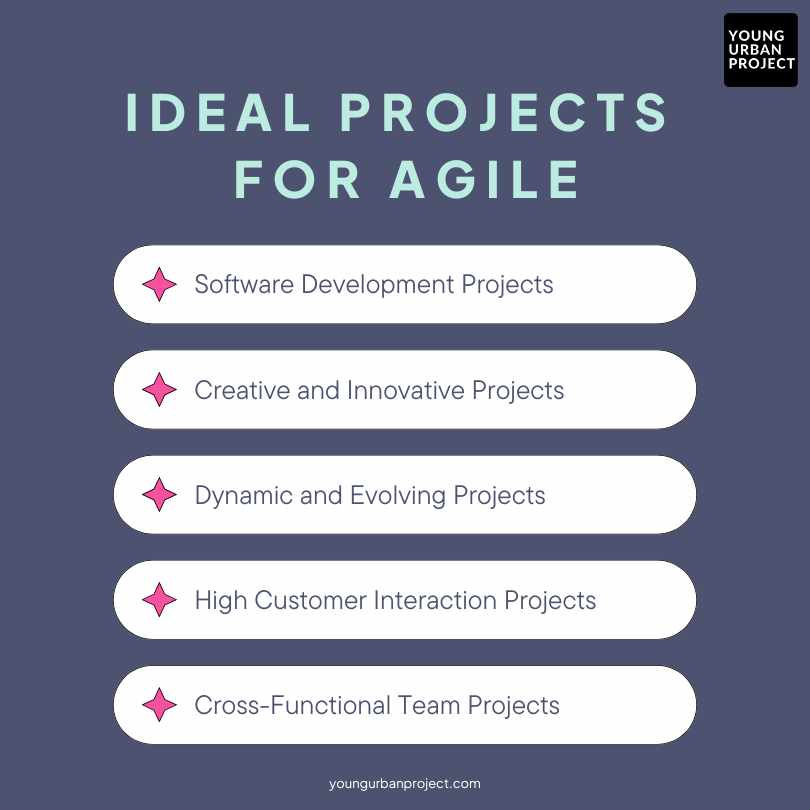
1. Software Development Projects
Agile nearshore software development is perfect for software development because project requirements often change. Teams can add features, test them, and improve the product with real-time feedback. This ensures the final product meets user needs and standards. Agile also helps fix issues and handle new needs without disrupting workflows. Teams can stay competitive by releasing updates regularly. This method is especially helpful for complex or innovative software projects.
2. Creative and Innovative Projects
For creative projects like app development or content creation, Agile shines. It allows teams to experiment and make small changes without fear of failure. Teams can pivot when needed, ensuring the final product stays relevant. Regular feedback encourages creativity and helps refine ideas. Agile strikes a balance between structure and flexibility, making it a great fit for industries like design and entertainment.
3. Dynamic and Evolving Projects
Agile works well for projects where requirements are unclear or constantly changing. Teams can adjust plans as goals become clearer. The iterative process shows stakeholders results early, building trust and confidence. This is particularly useful in fast-paced industries like tech or marketing. Agile embraces change, keeping projects on track despite shifting priorities.
4. High Customer Interaction Projects
Agile is ideal for projects where customer input shapes the outcome. Teams gather feedback during sprint reviews and make adjustments to meet client needs. This reduces dissatisfaction and ensures the final product provides value. Agile builds trust and strong relationships by focusing on customer priorities. It’s especially effective for user-focused projects like product design or service development.
5. Cross-Functional Team Projects
Agile is great for projects with diverse teams, such as design, marketing, and development. Regular meetings keep everyone aligned and reduce delays. Agile fosters collaboration, tapping into the strengths of each team member. This approach is perfect for projects like launching a new product or campaign, where input from multiple departments is crucial.
Waterfall Methodology
The Waterfall methodology is one of the oldest and most widely recognized project management approaches, known for its structured and linear process. Originating from the manufacturing and construction industries, it is designed for projects where requirements are clearly defined from the start. The methodology divides work into distinct phases—such as requirement gathering, design, development, testing, and deployment—ensuring each phase is completed before the next begins. This sequential approach provides clarity, predictability, and detailed documentation, making it suitable for projects with minimal scope for change. Despite its benefits, the rigid nature of Waterfall can be a challenge for dynamic or evolving projects.

Benefits of Waterfall Methodology
1. Clear Structure and Sequential Process
The Waterfall method has a straightforward, step-by-step process. It includes stages like gathering requirements, designing, developing, testing, and deploying. Each step is completed before moving to the next, ensuring nothing is missed. This structure works well for projects with clear requirements from the start. The organized approach reduces confusion, promotes accountability, and ensures detailed documentation. It’s a reliable choice for simple and predictable projects.
2. Comprehensive Documentation
The Waterfall method prioritizes creating detailed documents. This includes project requirements, design plans, and testing steps. These documents provide a clear guide for the entire project. They help everyone understand the goals and what needs to be delivered. Documentation is especially helpful for projects that require legal compliance or long-term upkeep. It also serves as a reference for new team members or future projects. By focusing on documentation, Waterfall ensures clarity and consistency.
3. Well-Defined Goals and Milestones
With Waterfall, goals and milestones are set early in the process. This gives everyone a clear idea of what to expect and when. Milestones make it easier to track progress and measure success. This is especially useful for projects with strict budgets, timelines, and deliverables. By defining objectives upfront, Waterfall helps keep the project on track and focused, making it ideal for stable, predictable projects.
4. Easy to Manage and Monitor
The step-by-step structure of Waterfall makes it easy to manage and monitor. Since each phase is completed before the next begins, project managers can quickly see if the project is on schedule and within scope. The defined stages also simplify assigning tasks, managing risks, and solving issues. This method is a great option for teams with little experience in Agile or for projects that need close supervision.
5. Ideal for Fixed-Requirement Projects
Waterfall works well for projects with clear, unchanging requirements. For example, it’s ideal for construction or manufacturing projects that follow strict guidelines. The structured process ensures the final results match the original plans. By sticking to a set plan, Waterfall minimizes unexpected changes and extra costs. This makes it a great choice for projects with a fixed scope and clear goals.
Ideal Projects for Waterfall
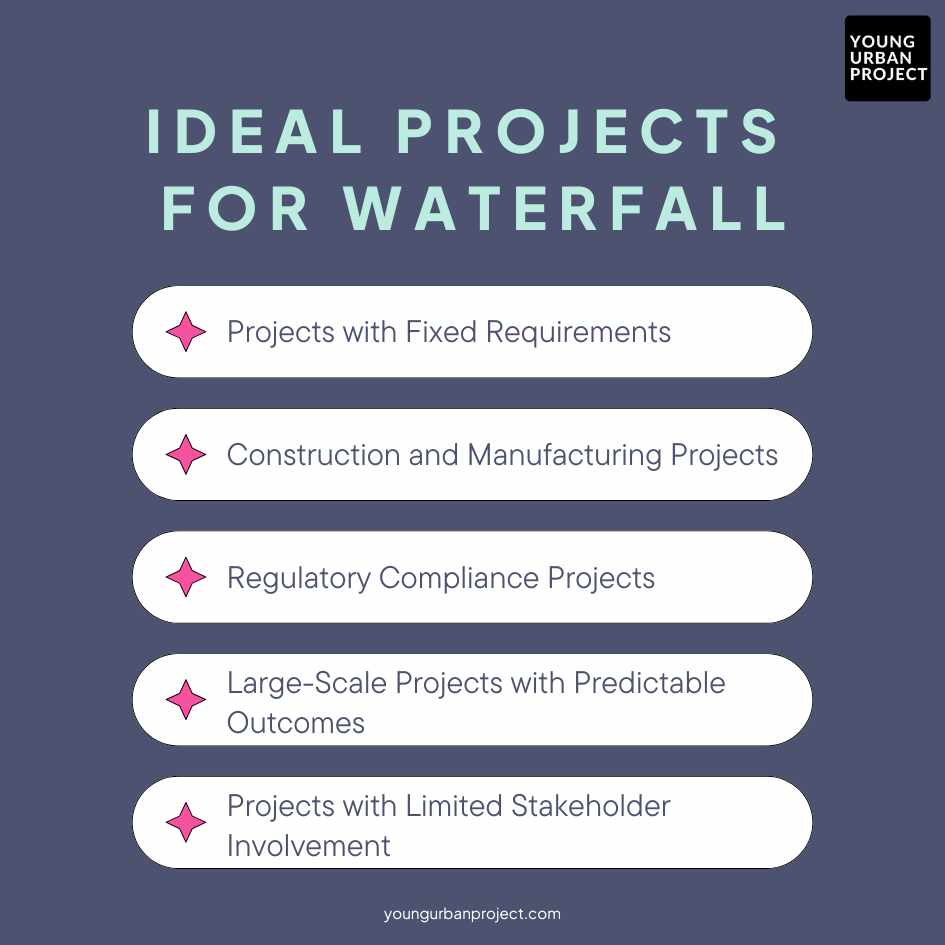
1. Projects with Fixed Requirements
Waterfall works best when project requirements are fixed and won’t change. For example, hardware development and government contracts benefit from a clear and predictable approach. When everything is planned in advance, teams can focus on execution without worrying about changes. This reduces confusion, simplifies decisions, and ensures the final product matches the original plan. It’s ideal for industries with strict rules or limited flexibility.
2. Construction and Manufacturing Projects
Construction and manufacturing rely on a step-by-step process. Projects move through stages like design, procurement, and assembly in sequence. Each phase is completed before the next begins. This approach ensures safety, keeps schedules on track, and avoids mistakes. Waterfall’s structured process is perfect for industries that need precision and compliance. By following a clear path, teams can avoid risks, delays, and extra costs.
3. Regulatory Compliance Projects
Highly regulated industries like healthcare and finance require strict documentation. Waterfall’s focus on detailed records ensures every step is tracked and meets compliance standards. This helps with audits and avoids penalties or recalls. By following a structured process, teams make sure no critical steps are missed. Waterfall provides the accountability needed for industries where following rules is crucial.
4. Large-Scale Projects with Predictable Outcomes
Waterfall is great for large projects with a clear scope and deliverables, like building infrastructure or rolling out software systems. Its structured phases help teams manage resources, reduce risks, and track progress effectively. Since each phase builds on the last, there’s less uncertainty. This keeps the project on track and ensures it’s completed on time and within budget.
5. Projects with Limited Stakeholder Involvement
Waterfall suits projects where stakeholders don’t need to be involved constantly. Requirements are gathered at the start, and stakeholders are mainly involved during reviews and approvals. This reduces disruptions and lets the team focus on their work. For example, hardware design or technical documentation projects benefit from this approach. Waterfall ensures stakeholder expectations are met without interrupting the team’s workflow.
Agile vs Waterfall: What’s the Difference?
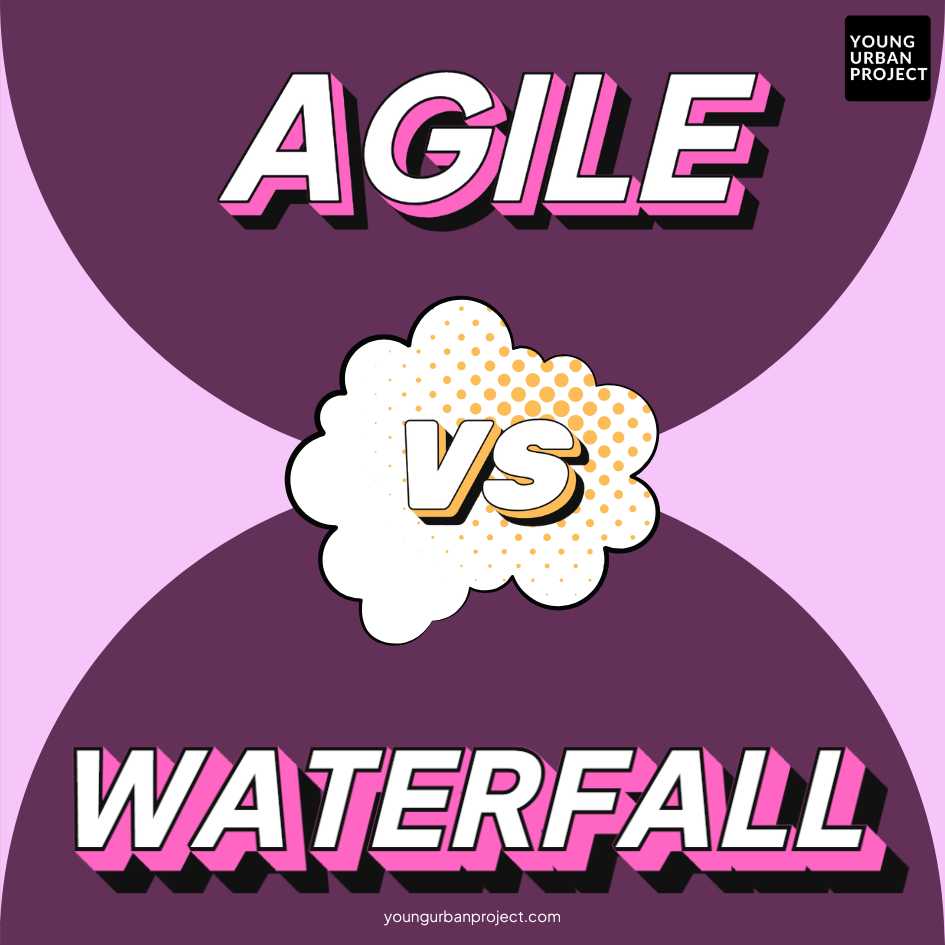
Agile and Waterfall are two contrasting project management methodologies, each suited to specific project types and industries. While Waterfall is a traditional, linear approach, Agile is a modern, flexible framework emphasizing iterative progress and adaptability. Choosing the right methodology depends on factors like project complexity, team dynamics, and stakeholder requirements. Below is a detailed comparison to help you understand the key differences between Agile and Waterfall.
| Aspect | Agile | Waterfall |
| Approach | Iterative and incremental, with continuous improvement. | Linear and sequential, with defined phases. |
| Flexibility | Highly flexible; changes can be made at any stage. | Rigid; changes are difficult once a phase is complete. |
| Project Phases | Overlapping and iterative; progress is achieved in small sprints or cycles. | Fixed and sequential; each phase must be completed before moving to the next. |
| Client Involvement | High; clients provide frequent feedback throughout the project. | Low; client involvement is typically limited to the initial and final stages. |
| Documentation | Minimal documentation; the focus is on working deliverables. | Extensive documentation is created and maintained for all stages. |
| Team Collaboration | Emphasizes cross-functional collaboration and self-organizing teams. | Teams follow hierarchical structures with clearly defined roles and responsibilities. |
| Risk Management | Risks are identified and mitigated iteratively. | Risks are identified upfront; limited adaptability to unforeseen issues. |
| Timeline | Flexible; timelines can be adjusted based on evolving requirements. | Fixed; timelines are established upfront and adhered to strictly. |
| Best Suited For | Projects with evolving requirements or where innovation and adaptability are key. | Projects with clearly defined objectives and stable requirements. |
| Delivery | Frequent, incremental deliveries of working features or products. | The final product is delivered at the end of the project. |
| Cost Estimation | Can vary as the scope evolves. | Fixed upfront based on predefined requirements. |
| Examples of Use | Software development, startups, product innovation. | Construction, manufacturing, regulatory projects. |
Factors to Consider When Choosing Between Agile and Waterfall
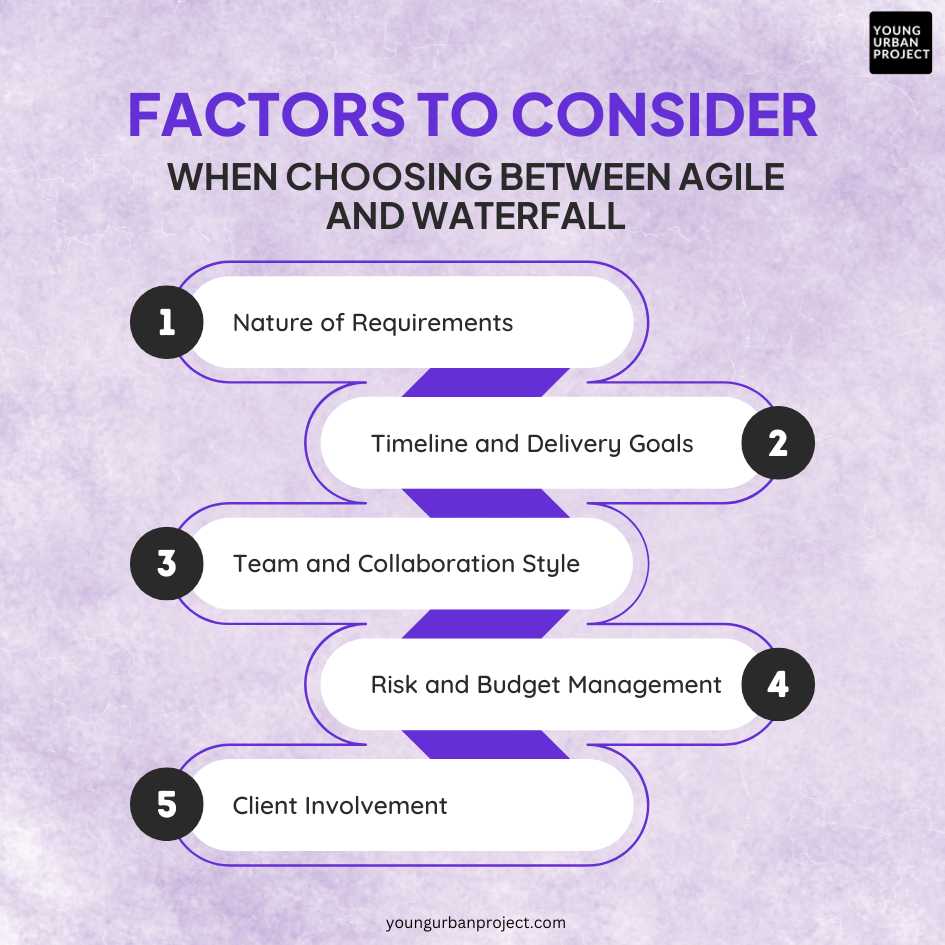
1. Nature of Requirements
Agile:
If your project has changing or unclear requirements, Agile is a great choice. Its step-by-step process allows changes at any stage. Frequent feedback and flexibility make it ideal for industries like software development, where updates and improvements are constant.
Waterfall:
For projects with fixed and clear requirements, Waterfall works best. Each stage—planning, designing, coding, testing, and deploying—is done one at a time. This method is great for projects where changes are costly, like construction or manufacturing.
2. Timeline and Delivery Goals
Agile:
Agile delivers work in small, regular chunks called sprints. This means stakeholders see progress and value throughout the project. Agile is perfect for flexible timelines and shifting goals since it can easily adapt to changes.
Waterfall:
Waterfall is ideal for projects with fixed deadlines and one final deliverable. Each phase has a set schedule, making it predictable. However, its rigid structure can delay fixing problems until the later stages.
3. Team and Collaboration Style
Agile:
Agile encourages teamwork and active involvement from everyone—developers, designers, and stakeholders. Daily meetings (like stand-ups) promote transparency and quick problem-solving. This is a good fit for creative teams where open communication is key.
Waterfall:
Waterfall works best for teams with clear roles and responsibilities. Each team focuses on its own phase, with little overlap. This approach suits large organizations or projects that depend on specialized expertise.
4. Risk and Budget Management
Agile:
Agile reduces risks by testing and improving constantly. Issues are spotted early, so they don’t grow into bigger problems. However, Agile’s flexibility can lead to changes in the budget, so it’s better for projects where costs can be adjusted.
Waterfall:
Waterfall plans the budget and risks in detail before the project begins. This makes costs predictable and helps avoid surprises. But since it’s harder to change plans mid-project, there’s a bigger risk if something goes wrong later.
5. Client Involvement
Agile:
Agile requires clients to stay involved throughout the project. Regular check-ins and feedback sessions ensure the final product matches their expectations. This is especially helpful for projects where client input is key, like software or product development.
Waterfall:
Waterfall limits client involvement to the start and end of the project. Once the requirements are set, the team works independently to meet them. This is better for projects where client time is limited, or changes are unlikely.
Also read: Key Product Management KPIs and Metrics Essential for Success
Which Methodology is Right for Your Project?
The best project management method depends on your project’s needs, goals, and limits.
Agile works well for projects where things might change. It’s great if flexibility is key. If you’re in software development, product design, or any field that needs quick updates, Agile is a good fit. It helps teams adapt to feedback and improve step by step. Agile also works when you need close teamwork with clients or stakeholders. It keeps everyone involved and ready for changes.
Waterfall, on the other hand, suits projects with clear, unchanging requirements. It’s great for tasks like construction, manufacturing, or compliance work. Waterfall follows a step-by-step process, making it easy to stay organized and avoid surprises. It’s ideal for projects with fixed timelines and budgets, where making changes later can be costly or hard.
Conclusion
Agile and Waterfall both have their strengths. Agile shines in fast-moving industries like software, where flexibility and regular feedback matter. Waterfall works best for projects with stable goals and strict schedules, such as building or manufacturing.
To pick the right method, think about your project’s needs, timeline, and risks. Match the method to your team’s style and the project’s goals. This way, you’ll set your project up for success.
FAQs
1. What is the main difference between Agile and Waterfall?
Agile is iterative and adaptable, allowing for constant feedback and incremental delivery. Waterfall is a linear and sequential process that requires each phase to be completed before proceeding to the next. Agile allows for adjustments in the middle of a project, whereas Waterfall adheres to a defined plan, making it more suited to projects with clear, unchanging requirements.
2. Which methodology is better for software development?
Agile is generally better for software development due to its adaptability, collaboration, and iterative delivery. It allows teams to respond to evolving requirements and client feedback. Waterfall may be suitable for software projects with fixed, well-defined requirements but lacks the flexibility Agile provides.
3. Can Agile and Waterfall be combined in a single project?
Yes, this hybrid approach is called “Agile-Waterfall.” For example, teams might use Waterfall for initial planning and Agile for execution and development phases. This combines the predictability of Waterfall with Agile’s flexibility, making it suitable for complex projects with diverse needs.
4. Which methodology is more cost-effective?
Waterfall is more cost-effective for projects with fixed requirements and budgets since changes are minimal. Agile can result in fluctuating costs due to ongoing iterations and changes, but it adds value by ensuring the final product aligns with evolving needs.
5. How does client involvement differ between Agile and Waterfall?
Agile involves clients throughout the project, with regular reviews and feedback after each sprint. In Waterfall, client involvement is primarily at the beginning (requirement gathering) and the end (final delivery), limiting input during the project’s progression.

